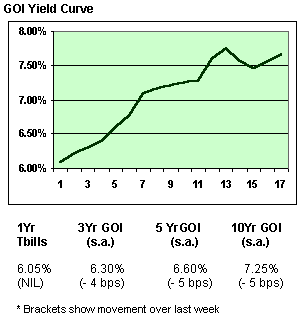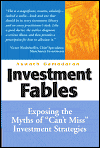Saturday, January 28, 2006
Cause and Effect: Stock Market Physics (Part II)
From Part I, we see that the expected return on stocks is above that of the risk-free return rate by a margin called the equity risk premium (ERP). The equation is:
Return on stocks = risk-free return + equity risk premium
Technically, the ERP ought to be multiplied by a risk factor, beta, which we will assume to be 1 for now. An ERP of 7% on top of a risk-free return rate of 7% results in an expected 14% return rate on stocks. The above equation does not imply that the return rate on stocks will be 14%. Quite the opposite, it means: make sure the price you pay for the stock will get you a 14% return on your investment.
What's the risk-free rate?
The usual suspects of the investment universe are stocks, bonds and government securities. Of the three, the least risk lies with goverment securities ( 'No one ever got fired for buying too many G-Secs' and all that). A popular benchmark used for the risk-free rate is the yield to maturity (YTM) of 10-year Government of India bonds which is market-determined.
Below is the image of the so-called yield curve showing the YTM of GOI bonds of different maturities. Note that bonds with longer maturities have higher yields to compensate for interest rate risk (risk of rising interest rates causing a fall in the security's price).
At the bottom of this yield curve is the Reserve Bank of India's repo rate. The repo (repurchase) rate is the interest that the Reserve Bank of India (RBI) will pay banks for parking their excess funds with the RBI. By controlling this ultra-short-term rate, the RBI can control the entire yield curve. The RBI has more controllable rates (the reverse repo rate and the bank rate) which we won't get into. Since changes in these rates imply changes in other interest rates in the economy, it really doesn't make a difference which interest rate you mean. They're all changing. You can just say 'rising interest rates' and everyone nods.
The butterfly effect
Increasing interest rates means that investors now expect greater returns on their money when investing in stocks. Since nothing about the companies and their businesses have changed after the rate hike, the stock prices will have to fall to yield this higher return. Assume that company A was priced at Rs.100 with an expection of 15% growth. If the risk-free rate increases by 1%, the expected return will increase by 1% to 16%. This means company A's stock price will fall to ~Rs.94 to yield 16% growth.
Further, debt is costlier for companies after the interest rate hike and that hits the valuation of stocks yet again. The interest rate hike increases the interest that companies will pay on their loans. More of a company's earnings will now go toward servicing debt leading to depressed earnings.
It's never so bad that it can't get worse. Suddenly, everyone is paying increased interest on their loans (home loans, auto loans, what have you) leaving less discretionary income. Less income equals less spending equals less sales equals less earnings.
A fall in interest rates has the opposite effect: Money is cheap, people spend more and the economy grows. We, here in India, have seen this side for the past few years with falling interest rates stimulating economic growth and consumer spending.
It pays to pay attention
With such wide-ranging effects on the economy, it pays to pay attention to interest rates and the rationale behind their use by the RBI. Being that we're all long-term investors here, the trend of interest rates changes is more important than the current interest rate. That trend ought to be factored into your calculations when you look at your next stock.
Don't you think that for an individual investor, the risk free rates can be say the fixed deposit rate or even better, the Post office scheme interest rate?
Regards,
Prasanth
<< Home


